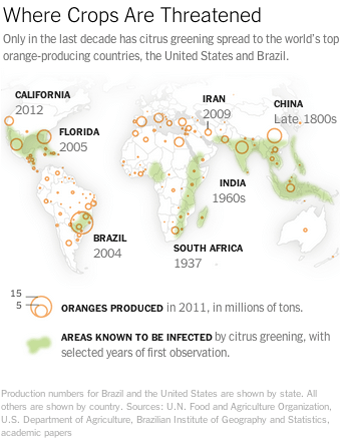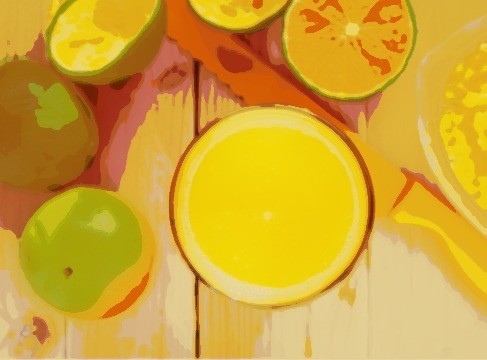Novel biotechnologies might help stop plant bacteria from exterminating orange and other citrus production
 All around the globe orange production is being affected by Huanglongbing (HLB), or in North America, ‘citrus greening’. Citrus greening is a disease which causes citrus trees to yellow, starving the tree and its fruit of nutrients. The cause of this disease is the Asian citrus psyllid, an insect which carries a bacteria that it spreads to the tree when it eats. Consequently, the bacteria cause the citrus fruit not to ripen, and in a matter of years the infected trees die. Orange production in Asia and South America has been affected for many years by HLB, but not until the past decade has production in the southern US has been impacted, particularly in Florida. The US is the world’s second-largest orange producer (10% in 2013), with Florida producing 66% in 2014/15. Since 2000, due to HLB Florida’s orange acres have declined 37%, causing job losses, and prices to increase.
All around the globe orange production is being affected by Huanglongbing (HLB), or in North America, ‘citrus greening’. Citrus greening is a disease which causes citrus trees to yellow, starving the tree and its fruit of nutrients. The cause of this disease is the Asian citrus psyllid, an insect which carries a bacteria that it spreads to the tree when it eats. Consequently, the bacteria cause the citrus fruit not to ripen, and in a matter of years the infected trees die. Orange production in Asia and South America has been affected for many years by HLB, but not until the past decade has production in the southern US has been impacted, particularly in Florida. The US is the world’s second-largest orange producer (10% in 2013), with Florida producing 66% in 2014/15. Since 2000, due to HLB Florida’s orange acres have declined 37%, causing job losses, and prices to increase.
There is no cure for citrus greening, therefore some orange tree supporters have suggested that biotechnology techniques be applied as a means of stopping the damage. Ed Stover, of the US Department of Agriculture, is working on transgenic research to resolve the citrus epidemic. The strategy to create citrus trees resistant to HLB is one step in helping to reverse the tree loss. Florida’s Southern Gardens Citrus is taking an active role in finding an immediate solution to HLB, GM and non-GM, and helping inform the public of the necessity to save the citrus industry.
Erik Mirkov of Texas A&M University, for over nine years, has been working to solve the problem of citrus greening, and might just have found a solution using spinach. Spinach has a protein, defensins, that has shown resistance to HLB. Defensins are destructive peptides (groups of amino acids) that kill bacteria, fungi and viruses. In April 2015, the Environmental Protection Agency granted Southern Garden Citrus permission to grow experimental varieties of oranges, grapefruit and lemons using the spinach’s defensins gene. With the creation of bacteria resistant orange trees with other pesticide initiatives (millions invested into therapeutic treatments to reduce the insects carrying the bacteria), the losses may be able to be stopped, helping in the recovery of orange trees.
If biotechnology can help save the orange industry, the question becomes whether these oranges will be successfully received by consumers and opponents to biotechnology. Opponents lobbying governments and consumers may cause the rejection these technologies. Will biotech and GM opponents recognize that the technology offers a unique solution? In 1998, GM papaya were released in Hawaii and readily accepted into the market, as they saved the industry from collapse. However, the political opposition to GM crops has dramatically changed since 1998.
Some consumer polling has indicated that consumers would be more receptive of biotechnologies that provide them direct benefits. The continued decline of the orange industry would drive up not only the price of oranges but orange juice as well. Already the losses from HLB have been adjusted for in the market by increased prices. Preventing this from further happening would certainly appear to be a direct consumer benefit.
While considerable attention is given to the decline of animal, amphibian and insect loss, less attention has been given to the loss of plant species. The continued sustainability of orange trees requires new breeding technologies that will allow these species to survive in the coming years and decades.


